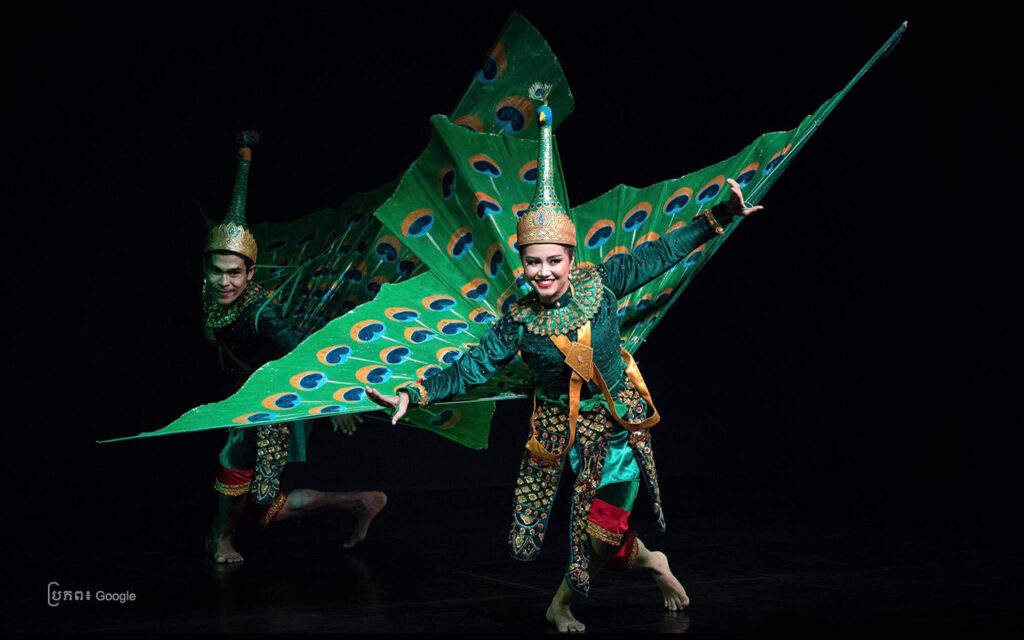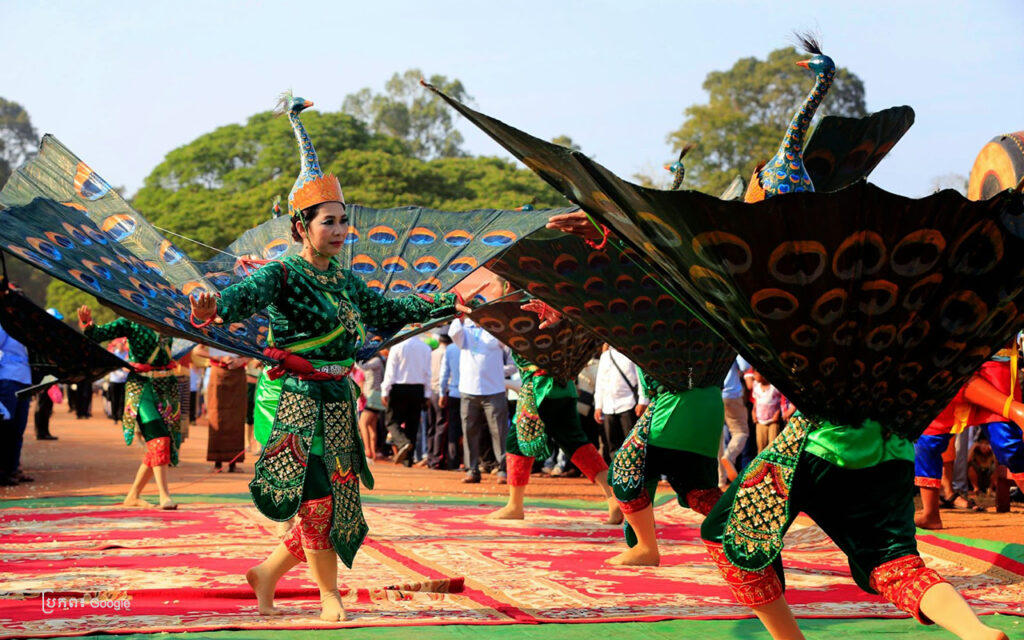នៅប្រទេសកម្ពុជា គេឃើញមានរបាំក្ងោកបីប្រភេទ គឺ៖ របាំក្ងោកពោធិសាត់ របាំក្ងោកភ្នំក្រវ៉ាញ និងរបាំក្ងោកប៉ៃលិន។
ខេត្តប៉ៃលិន ដែលមានព្រំប្រទល់ជាប់នឹងប្រទេសថៃឡង់ សម្បូណ៌ទៅដោយរ៉ែត្បូងដែលមានតម្លៃ។ ធនធាននេះត្រូវបានជនជាតិខ្មែរកូឡា ដែលមានដើមកំណើតជនជាតិភូមា និងបានមករស់នៅក្នុងតំបន់នេះជាច្រើនជំនាន់មកហើយនោះ ក៏បានទាញយកផលពីធនធានធម្មជាតិនេះ។ របរចិញ្ចឹមជីវិតសំខាន់ជាងគេរបស់ជនជាតិខ្មែរកូឡា គឺការជីកយករ៉ែត្បូងដ៏មានតម្លៃ។
មិនខុសគ្នានឹងខេត្តពោធិសាត់ ខេត្តប៉ៃលិនក៏មានរបាំក្ងោកដែលគេហៅថា «របាំក្ងោកប៉ៃលិន»។ សត្វក្ងោកជានិមិត្តរូបនៃសុភមង្គល។ ទោះបីជាប្រជាជនចូលចិត្តឬមិនចូលចិត្តធ្វើត្រាប់តាមសត្វក្ងោកក្តី ក៏របាំនេះត្រូវបានគេបង្កើតឡើងនិងច្នៃប្រឌិតឱ្យមានលក្ខណៈរស់រវើកនិងទាក់ទាញ ដូចមាននៅលើពណ៌ដ៏ស្រស់ស្អាតនៃស្លាបក្ងោកជាដើម។ របាំក្ងោកប៉ៃលិន បង្ហាញពីការចែចង់រវាងសត្វក្ងោកឈ្មោលនិងក្ងោកញី។ របាំនេះត្រូវបានគេនិយាយថានាំមកនូវភាពសប្បាយរីករាយនិងភាពចម្រុងចម្រើនដល់អ្នកស្រុកអ្នកភូមិ។ ហេតុដូច្នេះហើយ បានជាយើងឃើញនៅក្នុងភូមិស្រុកនាខេត្តប៉ៃលិន របាំនេះត្រូវបានគេសម្តែងក្នុងពិធីបុណ្យចូលឆ្នាំ និងឱកាសផ្សេងៗទៅតាមតម្រូវការ។
របាំក្ងោកប៉ៃលិន ត្រូវបានគេសម្រួលយកចេញពីរឿងនិទានដែលទាក់ទងនឹងសត្វក្ងោក និងព្រានព្រៃដូចតទៅ៖
មានព្រះនាងមួយអង្គបានផ្ទំយ៉ាងស្កប់ស្កល់និងសុបិន ឃើញសត្វក្ងោកដ៏សង្ហាមួយដែលចេះវេទមន្ត និងច្រៀងផង។ ក្នុងសុបិន ការច្រៀងរបស់សត្វក្ងោកនោះបានទាក់ទាញអារម្មណ៍ព្រះនាងយ៉ាងខ្លាំង។ ក្រោយពេលដែលព្រះនាងតើនឡើង ក៏គិតថាតើធ្វើយ៉ាងណាដើម្បីបានសត្វក្ងោកនោះមកច្រៀងឱ្យព្រះនាងស្តាប់ម្តងទៀត។ ព្រះនាងបានប្រែជាសោកសៅ មិនសោយក្រយា និងផ្ទំមិនលក់។ ដោយទតឃើញអាការៈមិនប្រក្រតីរបស់បុត្រី ព្រះរាជា ទ្រង់សួរទៅកាន់បុត្រី ហើយព្រះនាងក៏បានឆ្លើយទូលថ្វាយទៅព្រះវរបិតាវិញ អំពីសុបិននិមិត្តរបស់ព្រះនាង និងសេចក្តីប្រាថ្នាចង់បានសត្វក្ងោកនោះមកច្រៀងថ្វាយព្រះនាង។
ព្រះរាជា ក៏បានត្រាស់បញ្ជាទៅព្រានព្រៃម្នាក់ដែលពូកែជាងគេនៅក្នុងព្រះរាជាណាចក្រឱ្យទៅស្វែងរកសត្វក្ងោកនោះ។ ក្រោយពីស្វែងរកសព្វទិសទីអស់ហើយ នាវេលាពេលព្រឹកមួយនោះ ព្រានព្រៃក៏បានឃើញសត្វក្ងោកមួយទំនៅលើមែកឈើ ហើយធ្វើសមាធិដោយបែរមុខទៅព្រះអាទិត្យ។ បន្ទាប់មក សត្វក្ងោកនោះក៏លោតចុះពីលើមែកឈើហើយរេរាំដោយក្តីរីករាយនិងសោមនស្ស។ ពេលនោះ ព្រានព្រៃក៏រៀបចំស្នានិងព្រួញប្រុងនឹងបាញ់ទៅលើសត្វក្ងោកកុំឱ្យវាហើរ ក្នុងគោលបំណងនឹងចាប់យកវាទៅថ្វាយព្រះរាជបុត្រីនៃព្រះរាជា។ ប៉ុន្តែ ព្រានព្រៃបាញ់មិនត្រូវសត្វក្ងោកនោះសោះ និងមានចម្ងល់យ៉ាងខ្លាំងថាហេតុអ្វី ឬក៏សត្វក្ងោកនោះមានសិល្ប៍វេទមន្តអាគមគាថាឬយ៉ាងណា?។
ពីរបីថ្ងៃបានកន្លងផុតទៅ ព្រានព្រៃបានតាមសង្កេតហើយដឹងថា សត្វក្ងោកនោះតែងតែងើបពីព្រលឹមនិងធ្វើសមាធិដោយដាក់ជើងទាំងពីររបៀបដូចជាសំពះ ទៅព្រះអាទិត្យនាទិសខាងកើត និងធ្វើដូចគ្នានៅពេលល្ងាចដោយដាក់ជើងសំពះទៅព្រះអាទិត្យនាទិសខាងលិច មុននឹងចូលដេក។ ព្រានព្រៃបានរកមធ្យោបាយបញ្ឈប់សត្វក្ងោកកុំឱ្យធ្វើសមាធិមួយថ្ងៃ ដើម្បីគេនឹងចាប់យកសត្វក្ងោកនោះឱ្យបាន។
នៅថ្ងៃបន្ទាប់ ព្រានព្រៃបានចាប់បានសត្វក្ងោកញីមួយយ៉ាងស្រស់ស្អាត ហើយក៏យកទៅលែងនៅក្នុងទីធ្លាខាងមុខកន្លែងដែលសត្វក្ងោកឈ្មោលនោះរស់នៅ។ នាព្រឹកនោះ សត្វក្ងោកឈ្មោលងើបឡើង ទទះស្លាបប្រុងនឹងធ្វើសមាធិដូចធម្មតា ស្រាប់តែឃើញសម្រស់ដ៏ស្រស់ស្អាតរបស់ក្ងោកញីនៅនឹងភ្នែក។ សត្វក្ងោកឈ្មោលក៏ដើរឆ្ពោះទៅរកសត្វក្ងោកញី តែត្រូវព្រានព្រៃចាប់បាន។ សត្វក្ងោកឈ្មោល ក៏បានសួរទៅព្រានព្រៃថា «តើអ្នកចង់បានអ្វីពីខ្ញុំ? ខ្ញុំបានចាកចោលព្រៃព្រឹក្សា មកនៅក្នុងព្រៃដ៏ជ្រៅនេះ ដើម្បីឱ្យឆ្ងាយពីការបរបាញ់នៃព្រានព្រៃ។ ហេតុអ្វីក៏អ្នកចង់ធ្វើបាបខ្ញុំ?» បន្ទាប់ពីបានឮសត្វក្ងោកឈ្មោលរៀបរាប់ដូច្នោះហើយ ព្រានព្រៃក៏មានចិត្តអាណិតអាសូរដល់សត្វក្ងោក និងឆ្លើយតបទៅវិញដោយពាក្យផ្អែមល្ហែមថា៖ «នែម្នាលសត្វក្ងោក ខ្ញុំនឹងមិនសម្លាប់អ្នកឡើយ ដោយខ្ញុំបានឃើញថាអ្នកជាអ្នកកាន់សីល ធ្វើសមាធិជារៀងរាល់ព្រឹក។ ហេតុដូច្នេះហើយបានជាខ្ញុំចាប់យកអ្នកទៅថ្វាយព្រះរាជបុត្រីនៃព្រះរាជា ព្រោះព្រះនាងបានសុបិននិមិត្តទៅឃើញសត្វក្ងោកមួយ ចេះច្រៀង ដែលព្រះនាងសព្វព្រះហឫទ័យចង់បានដើម្បីនឹងបានស្តាប់វាច្រៀង»។ សត្វក្ងោកបានឮដូច្នោះ ក៏មានសេចក្តីរីករាយសោមនស្សនិងឆ្លើយថា៖ «ដូច្នេះសូមព្រានកុំព្រួយ ខ្ញុំនឹងទៅច្រៀងថ្វាយព្រះនាងនៅរាល់ថ្ងៃសីលចាប់ពីថ្ងៃនេះតទៅ»។ ចាប់ពីពេលនោះមក សត្វក្ងោកក៏តែងតែទៅច្រៀងថ្វាយព្រះនាង។ ដោយជឿទៅលើជំនឿនេះ ខ្មែរកូឡានាខេត្តប៉ៃលិន និយមសម្តែងរបាំក្ងោករបស់គេនៅរៀងរាល់ថ្ងៃសីល។
នៅពេលដែលសាកលវិទ្យាល័យភូមិន្ទវិចិត្រសិល្បៈយករបាំនេះមកតម្លើង ធាតុដើមខ្លះនៃរបាំត្រូវបានគេដកចេញ ហើយធាតុថ្មីត្រូវបានគេបន្ថែម។ ប្រធានបទនិងខ្លឹមសាររបស់របាំ ត្រូវបានគេកែប្រែមកបង្ហាញពីការចែចង់រវាងក្ងោកញីនិងឈ្មោលវិញ។ វង់តន្ត្រីកំដររបាំក្ងោកប៉ៃលិន មាន៖ ស្គរឆៃយ៉ាំ១ ស្គរភ្លោះ១គូ ស្រឡៃប៉ៃលិន១ ឆាប២គូ គងម៉ង់១ និងអ្នកច្រៀងម្នាក់ ដែលយើងឃើញមាននៅប្រើរហូតដល់សព្វថ្ងៃ៕
——————————————————–
PEACOCK OF PAILIN DANCE
In Cambodia, there are three types of peacock dances: the Robaim Kngaok Posatt (Peacock of Pursat Dance), Robaim Kngaok Phnum Kravanh (Peacock of Kravanh Mountain Dance), and Robaim Kngaok Pailin (Peacock of Pailin Dance), as they have been referred to.
The region of Pailin, which borders upon Thailand, is rich in precious stones. This resource is exploited by the Kula-Khmer, who are of Burmese origin, and who have inhabited this region for generations. Their major activity is precious stone mining, and they are consequently known as masters of this trade.
As in Pursat, a peacock dance is also realized in Pailin. Peacock is a symbol of happiness. Whether or not people like to imitate the peacock, this dance is adapted in the most realistic fashion possible. The close resemblance of the canvas to the lively colors of beautiful wings, spectacularly suggests a courting scene between a peacock and a peahen. This dance is said to bring happiness and prosperity to villagers. For that reason, as we see in the locality, the dance is performed during the New Year or at special occasions when called for.
The original performance of this dance was adapted from a tale involving a peacock and a hunter as follows:
There was a princess who was soundly asleep and dreamed of a handsome peacock which knew magic spells and chanting. In her dream, she was carried away by the peacock’s chanting. When she woke up, she wondered how to get the peacock to come and chant for her again. The princess became sad, lost her appetite, and lost sleep. Noticing his daughter’s unusual behavior, the King, the father asked the princess, who in response, told the King of the dream and her wish to have the peacock to come and chant for her.
The King thus orders the best hunter in the Kingdom to find the peacock. After an exhaustive search, one morning, the hunter encountered a peacock perching on a branch of a tree, meditating facing the sun. Then, it jumped from the tree and danced happily. The hunter prepared his bow and arrow ready to shoot and stop the peacock from flying away in order for him to catch and present it to the princess. But the hunter missed every shot at the peacock. With great astonishment, the hunter caught a glimpse at the peacock wondering why; perhaps the peacock had magic spells. A few days passed by, the hunter found that the peacock woke up early in the morning and meditated with its feet together in salutation fashion toward the eastern sun. The peacock did the same in the evening toward the western sun before going to sleep. The hunter then tried to find a way to stop the peacock from doing that for one day, so he would be able to capture the peacock.
The following day, the hunter caught a beautiful peahen and let it go free it in front of the dwelling quarter of the peacock. In the morning, the peacock flapped its wings ready for the meditation but saw the beauty appearing in front of its eyes. The peacock approached the peahen and got trapped by the hunter: The peacock then asked the hunter: “What do you want me for? I have left the local forest coming to live in the deep one away from hunting. Why do you want to hurt me?” After hearing the peacock, the hunter felt pity for the peacock and replied with sweet words: “Dear peacock, I will not kill you. I saw that you are a saint, meditating every morning. That is why I capture you to present to the King’s daughter, because she dreamed of a peacock which knew how to chant, and the princess wants to hear it chant.”
The peacock was amused and replied: “If so, don’t worry. I will go to chant for her every holy day from now on.” From then on, the peacock always comes to chant for the princess. Because of such belief, the Kula-Khmer of Pailin performs the peacock dance every holy day.
When it was brought to the Royal University of Fine Arts, some of the original elements were eliminated and some new ones were added. The theme was changed and now emphasizes courting action. The musical ensemble includes a long drum, a twin-double-headed barrel drum called Skor Pluoh, a shawm, two pairs of cymbals of different sizes, one medium-sized knobbed gong, and a vocalist, all of which are still preserved and used to accompany the present dance.
អត្ថបទដើម៖ បណ្ឌិត សំ សំអាង








